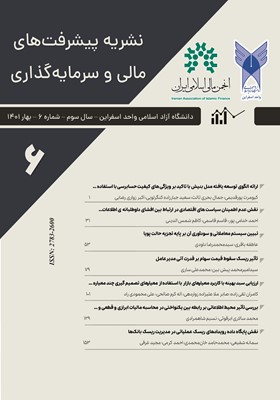Presenting the developed model of benish model with emphasis on audit quality fea-tures using neural network, vector machine and random forest
Subject Areas : Islamic financeKiumars Pourgadimi 1 , Jamal Bahri Sales 2 , Saeed Jabbarzadeh Kangarluei 3 , Akbar Zavar Rezaee 4
1 - Department of Accounting, Urmia Branch, Islamic Azad University, Urmia, Iran.
2 - Department of accounting, Islamic Azad University Urmia Branch, Urmia, Iran
3 - Department of Accounting, Urmia Branch, Islamic Azad University, Urmia, Iran.
4 - Department of Accounting, Urmia University, Urmia, Iran.
Keywords: Neural network, Banish model, audit quality characteristics, vector machine and random forest,
Abstract :
Purpose: As the business process becomes more complex, the risk of financial statements being distorted increases with each passing day. In this regard, researchers have been looking for models to detect fraud in financial statements. The purpose of this research is to present an expanded model based on the quality characteristics of the auditor.Methodology: Benish (1997) used a combination of financial ratios and accruals to predict profit manipulation methods. Since auditors are presented as external oversight in the corporate governance structure of the company's performance, in this study the model is developed based on the qualitative char-acteristics of the auditor, which include the auditor's size, auditor tenure, reporting delay, Auditor Class and Auditor Change. The fitting of the vector machine, random forest and neural network has been used to fit the ex-tended model.Findings: The results show that the coefficients obtained from the random forest model are 98.4% and more than the two neural network and vector model 93%. Also, the extended model is more accurate than the base model. Audit characteristics are influential in predicting fraud in financial statements and should be considered by capital market participants.Originality / Value: Research findings can be effective in improving the prediction of fraud in financial statements and also draw users' attention to the combination of financial statement information and the characteristics of the auditor's report in fraud prediction.
Kyle, A. S. (1985). Continuous Auctions and Insider Trading. Econometrica, 53(6), 1315.
Power, M. (2004). The risk management of everything. The Journal of Risk Finance, 5(3), 58–65.
Watts, R. L., & Zimmerman, J. L. (1986). Positive accounting theory. Prentice-Hall.
_||_


